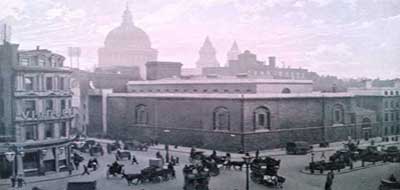
This is a truly delightful walk that really does take you away from the hustle and bustle of modern London and transports you back to the teeming streets of the London of Charles Dickens.
But it also includes a visit to a truly timeless part of London where. at any moment, you almost expect to see Dickens himself strolling across one of the flag-stoned courtyards.
The walk begins beneath the majestic splendour of St Paul’s Cathedral, where we picture Dickens and his family ascending the steps of Sir Christopher Wren’s masterpiece to attend the funeral of the Duke of Wellington in 1852. Dickens wasn’t particularly impressed by the spectacle that he witnessed, and his distaste for the ceremony was instrumental in his desire that he would, when the day came, have a quieter and far less ostentatious ceremony.
From Dickens confronting and considering his own mortality, we follow in his footsteps through a a medley of atmospheric old streets to the site of Doctors Commons.
Dickens came to work here as a young man, and he would later send his most autobiographical character, David Copperfield, to do likewise.
Although this part of legal London vanished long ago we are able to look at it through Dickens eyes and let him describe it to us.
Having pondered this, now vanished, aspect of legal London, and having viewed it through the eyes of Charles Dickens, we move on past a church that once counted William Shakespeare amongst its neighbours.
From here we cross Ludgate Hill, hearing what Dickens had to say about it in the opening pages of Bleak House. Having done so, we make our way to the site of Newgate Prison – once London’s most infamous and notorious prison – where you will hear Dickens describe Fagin’s last night here in Oliver Twist and oflearn Magwitch’s last moments in the prison infirmary in Great Expectations.
Next, we descend the banks of one of London’s underground rivers to visit the site of the Fleet Prison to hear of Mr Pickwick’s experiences here in Pickwick Papers.
Then, our walk through Dickens London wends its way through the alleyways and passageways off Fleet Street, many of them known to Dickens, and many of them written about by him.
You will gaze upon Sir Christopher Wren’s most beautiful church spire before delving into a sinister old alley where Dickens set the abode of Jerry Cruncher in A Tale of Two Cities.
This will bring us to one of the City of London’s most tucked away alleyways, the walls of which are lined with tiled panels that tell the story of printing and publishing on nearby Fleet Street. It is a good spot to introduce the problems that Dickens encountered when unscrupulous publishers plagiarised his works and often tried to pre-empt his endings! You will also see the newspaper that Dickens founded and of which he set himself up as editor, with disastrous consequences!
For the final section of the tour we follow Dickens in to is one of London’s least changed enclaves. It is made up of picturesque gardens, echoing courtyards and time-coated passageways that have changed little, if at all, since Dickens wrote of it that you can read on its gates “who enters here leaves noise behind.”
Located in this tranquil area is the grave of the man from whom Dickens derived the pseudonym under which his early works appeared Boz.
Having learned how the name came about (and it really is a fascinating story) the tour ends alongside the magnificent red-brick residence where Pip was lodging when, one storm tossed night, Magwitch turned up to make himself known as the source of Pip’s Great Expectations.
So, join Dickens expert Richard Jones on an enchanting journey through the streets, courts, passageways and alleyways that are still as they were when Dickens walked them.